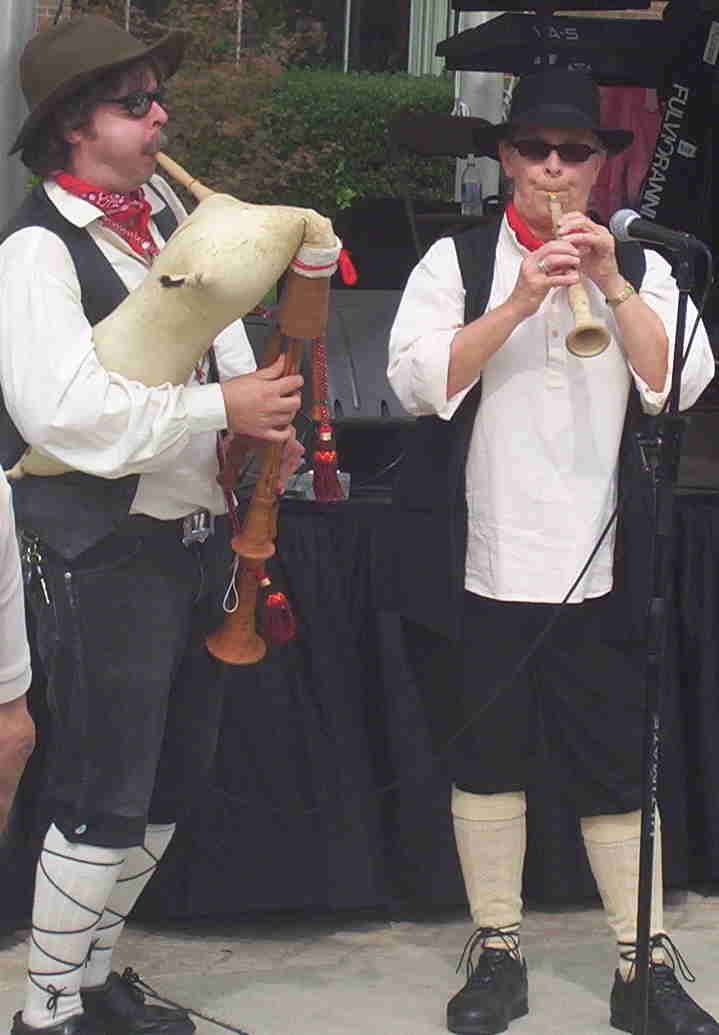by Charlie Rutan
 There I was in my backyard, fully charged cordless razor in one hand and a fresh Calabrian goatskin in the other. I’ve long ago given up being concerned about what my neighbors think. It’s amazing how much hair is on a goat: a close shave takes at least half the weight off of the pelt.
There I was in my backyard, fully charged cordless razor in one hand and a fresh Calabrian goatskin in the other. I’ve long ago given up being concerned about what my neighbors think. It’s amazing how much hair is on a goat: a close shave takes at least half the weight off of the pelt.
You think this is dedication? Nope. Earlier that month I had sent my mechanic on a fruitless search for a few spare truck inner tubes. Dedication? Wrong again. Let’s jump to the scene in the grocery store, as I turned over container after container of yoghurt, looking for “# 6” plastic for reeds. And yet, we’re still not talking ‘dedication’.
It was not until the day that I gingerly stretched a warm, wet, rubbery goat’s neck skin over a ceppo (kind of like a mainstock) ; did I come to the realization that I was engaging in an ancient, timeless act that demanded respect of the animal that gave its life for my zampogna. This is a living instrument, despite the reeds made from 7-11 Slurpee cups.
Although I have yet to resurface the ice between periods of an NHL game, I know for certain that I could retire comfortably, had I but 10 cents for everyone who has called this living instrument of mine… a “Zamboni”. Ha, ha.
There is indeed a disconnect between Italian-Americans and Italians concerning this bagpipe. For some, it belongs to “Old Italy”, the Italy they left behind, where grandparents suffered in poverty, dreaming of the gleaming light of liberty calling them over. Yet for others, it represents continuance. Solidarity. Dependability that the zampogna and ciaramella will be there, this Christmas too, to sound “Piva, Piva”, or ‘Tu Scendi” at Midnight Mass on Christmas Eve. Heck: we even have a special dispensation to wear our hats on the altar !
Every December, we see it in the eyes of the kids, and the eyes of the very old: “My Nonna had them come by every Annunciation”. “My Poppa had zampognari in his village, and I have not heard this since I left Italy as a little boy”. “You bring back such..memories !”
Then the kids will say: “Wow those are great! You mean there’s an Italian bagpipe too?” Cool, but where’s your Kilt? And can you play Amazing Grace?” Well, yes, but we chose not to. Nor yet ‘Mambo Italiano’, ‘Three Coins in the Fountain’, or ‘Al di La’. We’re working on Rosinni, and the theme from the Godfather, because we think you’ll like those a lot. Sinatra’s copyrighted, so fagettabouitit. We know you mostly listen to hip-hop, but we had you dancing in the park anyway. If only one of the ‘Jersey Shore’ kids would dig this as much as you just did. Then I could really retire. But I can’t: there will always be someone for whom Christmas cannot be complete without a visit from the zampognari playing Tu Scendi dalle Stelle.
They came over, wrapped up with the luggage; and were a touchstone, for a generation. But eventually they were put away. The reeds wouldn’t work anymore, or the bag rotted in the distinctly un-Mediterranean climate, or the zampognaro died.
People forgot. They still had the presepio figurine, of course; faithfully it was positioned once a year between St Joseph, the Magi, and the sleeping sheep. Yet, it was not a living, breathing thing: as it once seemed, and it was carefully wrapped in tissue paper or newapaper, and solemnly replaced for use next year. Hey- what’s this thing in Aunt Tina’s closet…think its worth any money? Let’s E-Bay it!
 Meanwhile, an ocean away, much like the fictional Gepetto, for years they laboured alone in sheds, garages and back rooms, during precious spare time, using the reamers their fathers & uncles had buried in the mountain when the Germans came. Although they were always present; slowly, there began to be more and more, zampogne and zampognari. Used phone cards replaced fickle cane. Seed money came from the government & the EU for folklife. Word spread.
Meanwhile, an ocean away, much like the fictional Gepetto, for years they laboured alone in sheds, garages and back rooms, during precious spare time, using the reamers their fathers & uncles had buried in the mountain when the Germans came. Although they were always present; slowly, there began to be more and more, zampogne and zampognari. Used phone cards replaced fickle cane. Seed money came from the government & the EU for folklife. Word spread.
Next came festivals, gatherings, concerts, lectures, and books. Old instruments were found, copied, and sold. (Wow- he’s playing …jazz on that thing? Va Bene! ) The older zampognari, who had continued the tradition in obscurity, became kind of legendary, celebrities almost, and sought-after craftsmen.
New traditions were born. Ancient ones were rediscovered. An ever-so tenuous connection to the new world was established, be it by Italians who came over in the 60’s & 70’s, “gringos” who liked the music & were nuts about bagpipes anyway, or Italian Americans seeking that lost touchstone. And here we are today, with the contrasting camps of ‘Moderna’ and ‘Tradizione’. Such a controversy tells me that the art of the zampogna is indeed on solid ground.